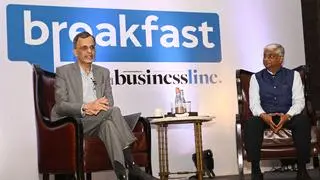The oligopoly of the three global rating agencies, Moody’s, Standard & Poor, and Fitch, needs to be dismantled, says V Anantha Nageswaran, Chief Economic Advisor to the Government of India.
In a conversation with businessline’s Editor Raghuvir Srinivasan, at a ‘breakfast with businessline’ meet, Nageswaran was wondering why there were only three global rating agencies “when the West is talking about market economy and competition.”
Responding to a question about the agencies, Nageswaran observed that any exercise, such as rating a country, should be replicable. “You and I should be able to look at the same data and come to the same conclusion,” he said.
Methodology
He said that there were many problems with the methodology of the rating agencies, such as “qualitative parameters” (which bring in an element of subjectivity) and the sources of information.
The rating agencies take inputs from the World Bank’s World Governance Index, which itself is “extremely problematic” because its own sources of information do not come from the countries assessed but from “think-tanks or research bodies sitting in some European countries.”
- Also read: India’s $3.7-trillion economy can absorb capital inflows comfortably, but needs reforms, says CEA
Describing the WGI as “opaque”, Nageswaran noted that the WGI does not take due note of the stage of development of a country. “As countries reach a particular stage of development, they discover the need for different institutions for governance. For them (rating agencies) to compare the institutions of developing countries and developed countries, where such institutions took several centuries to evolve, is not a fair comparison.”
He said that the financial meltdown of 2008 (which proved the rating agencies wrong) was a good moment to take a re-look at the credit rating space, but was unfortunately missed.
India employment report
Asked about the recent India Employment Report, 2024, of the International Labor Organization, which showed a bleak picture of employment in India, Nageswaran said that the report was not fair inasmuch as it compared two points in time — 2000 and 2022 — and not showing the path traversed. He noted that unemployment was higher in the early years and then started declining.
Also, 2022 was a pandemic-hit year, Nageswaran pointed out. The pandemic brought about 40 million people back into agricultural jobs. But now that manufacturing is improving, the labor trend is reversing.
The CEA further noted that there were also many positive points in the ILO report. Between 2014 and 2022, India created 77 million non-agricultural jobs per year, compared with 66 million annually in the previous ten years, Nageswaran said.





Comments
Comments have to be in English, and in full sentences. They cannot be abusive or personal. Please abide by our community guidelines for posting your comments.
We have migrated to a new commenting platform. If you are already a registered user of TheHindu Businessline and logged in, you may continue to engage with our articles. If you do not have an account please register and login to post comments. Users can access their older comments by logging into their accounts on Vuukle.